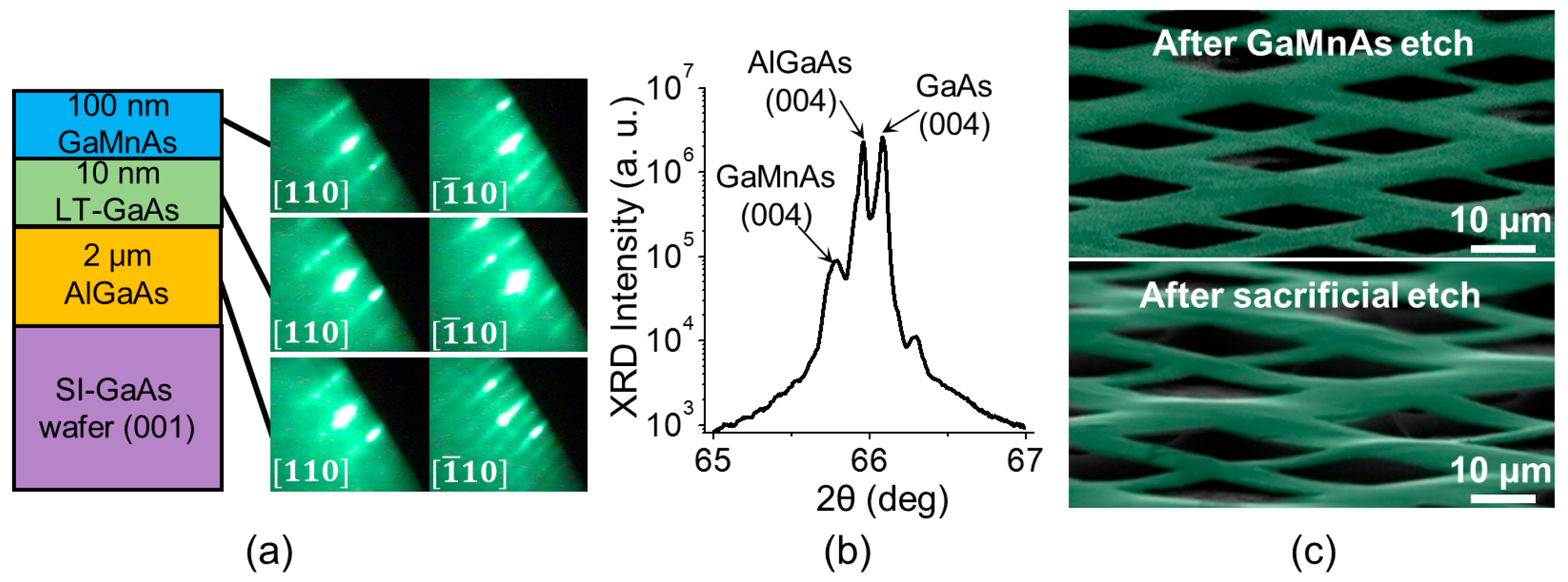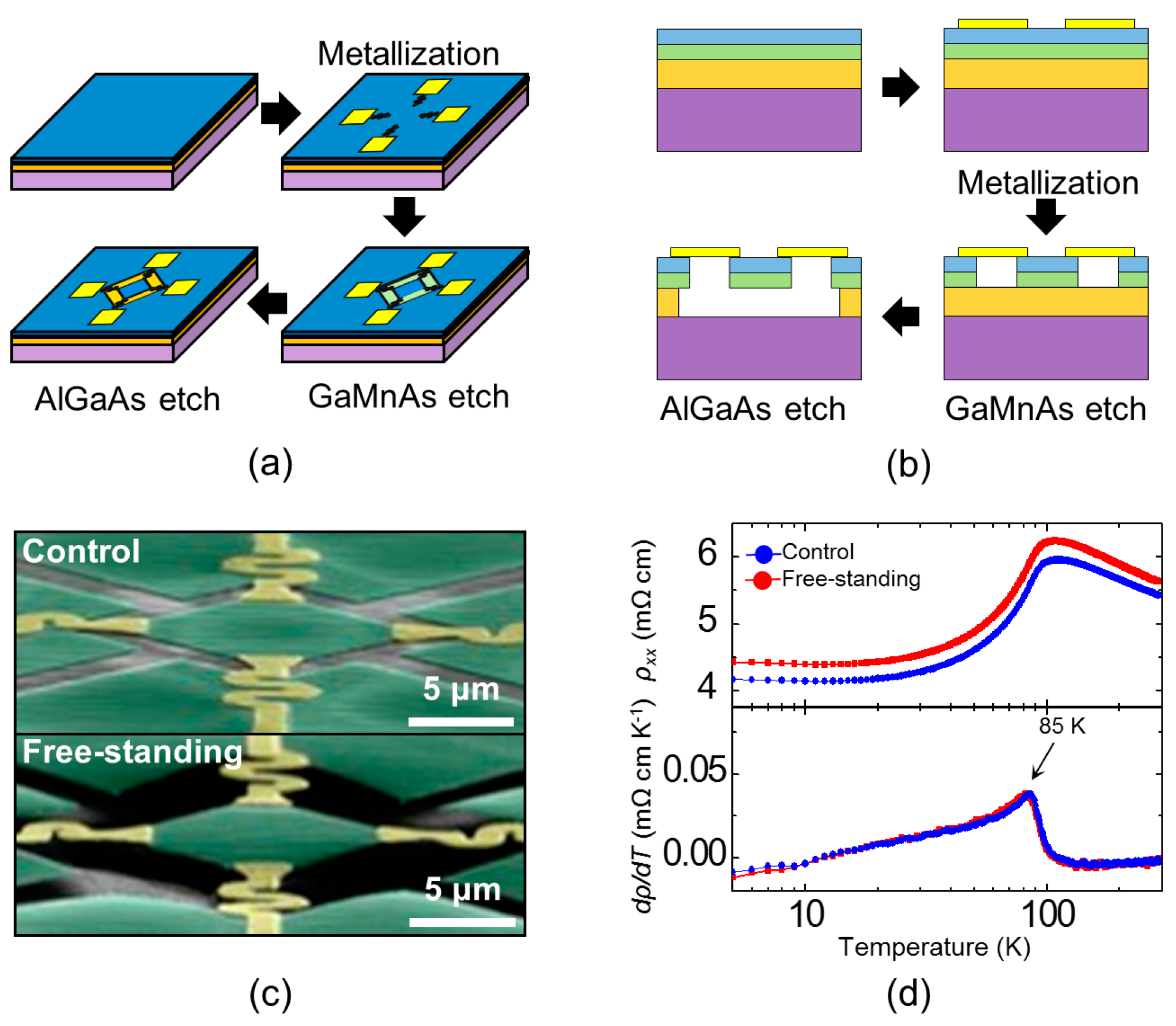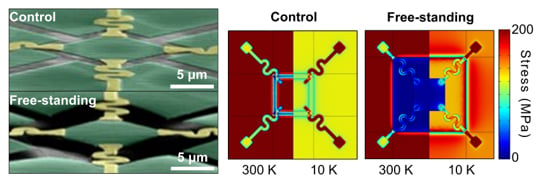Free-Standing GaMnAs Nanomachined Sheets for van der Pauw Magnetotransport Measurements
Abstract
:1. Introduction
2. Materials and Methods
3. Results and Discussion
4. Conclusions
Acknowledgments
Author Contributions
Conflicts of Interest
References
- Ohno, H.; Shen, A.; Matsukura, F.; Oiwa, A.; Endo, A.; Katsumoto, S.; Iye, Y. (Ga,Mn)As: A new diluted magnetic semiconductor based on GaAs. Appl. Phys. Lett. 1996, 69, 363–365. [Google Scholar] [CrossRef]
- Jungwirth, T.; Wunderlich, J.; Novák, V.; Olejník, K.; Gallagher, B.L.; Campion, R.P.; Edmonds, K.W.; Rushforth, A.W.; Ferguson, A.J.; Němec, P. Spin-dependent phenomena and device concepts explored in (Ga,Mn)As. Rev. Mod. Phys. 2014, 86, 855–896. [Google Scholar] [CrossRef]
- Jungwirth, T.; Sinova, J.; Mašek, J.; Kučera, J.; MacDonald, A.H. Theory of ferromagnetic (III,Mn)V semiconductors. Rev. Mod. Phys. 2006, 78, 809–864. [Google Scholar] [CrossRef]
- Ohno, H.; Chiba, D.; Matsukura, F.; Omiya, T.; Abe, E.; Dietl, T.; Ohno, Y.; Ohtani, K. Electric-field control of ferromagnetism. Nature 2000, 408, 944–946. [Google Scholar] [CrossRef] [PubMed]
- Park, Y.D.; Hanbicki, A.T.; Erwin, S.C.; Hellberg, C.S.; Sullivan, J.M.; Mattson, J.E.; Ambrose, T.F.; Wilson, A.; Spanos, G.; Jonker, B.T. A group-IV ferromagnetic semiconductor: MnxGe1−x. Science 2002, 295, 651–654. [Google Scholar] [CrossRef] [PubMed]
- Rozkotová, E.; Němec, P.; Horodyská, P.; Sprinzl, D.; Trojánek, F.; Malý, P.; Novák, V.; Olejník, K.; Cukr, M.; Jungwirth, T. Light-induced magnetization precession in GaMnAs. Appl. Phys. Lett. 2008, 92, 122507. [Google Scholar] [CrossRef]
- Matsukura, F.; Ohno, H.; Shen, A.; Sugawara, Y. Transport properties and origin of ferromagnetism in (Ga,Mn)As. Phys. Rev. B 1998, 57, R2037–R2040. [Google Scholar] [CrossRef]
- Tang, H.X.; Kawakami, R.K.; Awschalom, D.D.; Roukes, M.L. Giant planar hall effect in epitaxial (Ga,Mn)As devices. Phys. Rev. Lett. 2003, 90, 107201. [Google Scholar] [CrossRef] [PubMed]
- Matsukura, F.; Sawicki, M.; Dietl, T.; Chiba, D.; Ohno, H. Magnetotransport properties of metallic (Ga,Mn)As films with compressive and tensile strain. Physica E 2004, 21, 1032–1036. [Google Scholar] [CrossRef]
- Wenisch, J.; Gould, C.; Ebel, L.; Storz, J.; Pappert, K.; Schmidt, M.J.; Kumpf, C.; Schmidt, G.; Brunner, K.; Molenkamp, L.W. Control of magnetic anisotropy in (Ga,Mn)As by lithography-induced strain relaxation. Phys. Rev. Lett. 2007, 99, 077201. [Google Scholar] [CrossRef] [PubMed]
- Yamanouchi, M.; Ieda, J.; Matsukura, F.; Barnes, S.E.; Maekawa, S.; Ohno, H. Universality classes for domain wall motion in the ferromagnetic semiconductor (Ga,Mn)As. Science 2007, 317, 1726–1729. [Google Scholar] [CrossRef] [PubMed]
- Chernyshov, A.; Overby, M.; Liu, X.; Furdyna, J.K.; Lyanda-Geller, Y.; Rokhinson, L.P. Evidence for reversible control of magnetization in a ferromagnetic material by means of spin-orbit magnetic field. Nat. Phys. 2009, 5, 656–659. [Google Scholar] [CrossRef]
- Jungwirth, T.; Niu, Q.; MacDonald, A.H. Anomalous hall effect in ferromagnetic semiconductors. Phys. Rev. Lett. 2002, 88, 207208. [Google Scholar] [CrossRef] [PubMed]
- Chun, S.H.; Kim, Y.S.; Choi, H.K.; Jeong, I.T.; Lee, W.O.; Suh, K.S.; Oh, Y.S.; Kim, K.H.; Khim, Z.G.; Woo, J.C.; et al. Interplay between carrier and impurity concentrations in annealed Ga1−xMnxAs: Intrinsic anomalous hall effect. Phys. Rev. Lett. 2007, 98, 026601. [Google Scholar] [CrossRef] [PubMed]
- Choi, H.K.; Kim, Y.S.; Seo, S.S.A.; Jeong, I.T.; Lee, W.O.; Oh, Y.S.; Kim, K.H.; Woo, J.C.; Noh, T.W.; Khim, Z.G.; et al. Evidence of metallic clustering in annealed Ga1−xMnxAs from atypical scaling behavior of the anomalous hall coefficient. Appl. Phys. Lett. 2006, 89, 102503. [Google Scholar] [CrossRef]
- Matsuo, M.; Ieda, J.I.; Maekawa, S.; Saitoh, E. Effects of mechanical rotation and vibration on spin currents. J. Korean Phys. Soc. 2013, 62, 1404–1409. [Google Scholar] [CrossRef]
- Ekinci, K.L.; Roukes, M.L. Nanoelectromechanical systems. Rev. Sci. Instrum. 2005, 76, 061101. [Google Scholar] [CrossRef]
- Clawson, A.R. Guide to references on III–V semiconductor chemical etching. Mater. Sci. Eng. R 2001, 31, 1–438. [Google Scholar] [CrossRef]
- Gould, C.; Rüster, C.; Jungwirth, T.; Girgis, E.; Schott, G.M.; Giraud, R.; Brunner, K.; Schmidt, G.; Molenkamp, L.W. Tunneling anisotropic magnetoresistance: A spin-valve-like tunnel magnetoresistance using a single magnetic layer. Phys. Rev. Lett. 2004, 93, 117203. [Google Scholar] [CrossRef] [PubMed]
- Chun, S.H.; Yu, J.P.; Kim, Y.S.; Choi, H.K.; Bak, J.H.; Park, Y.D.; Khim, Z.G. Vertical spin transport in MnAs/GaMnAs heterostructures. J. Magn. Magn. Mater. 2006, 304, e337–e339. [Google Scholar] [CrossRef]
- Choi, H.K.; Lee, J.S.; Cho, S.W.; Lee, W.O.; Shim, S.B.; Park, Y.D. Regrowth of diluted magnetic semiconductor GaMnAs on InGaP (001) surfaces to realize freestanding micromechanical structures. J. Appl. Phys. 2007, 101, 063906. [Google Scholar] [CrossRef]
- DeSalvo, G.C.; Tseng, W.F.; Comas, J. Etch rates and selectivities of citric acid/hydrogen peroxide on GaAs, Al0.3Ga0.7As, In0.2Ga0.8As, In0.53Ga0.47As, In0.52Al0.48As, and InP. J. Electrochem. Soc. 1992, 139, 831–835. [Google Scholar] [CrossRef]
- Harris, J.G.E.; Awschalom, D.D.; Matsukura, F.; Ohno, H.; Maranowski, K.D.; Gossard, A.C. Integrated micromechanical cantilever magnetometry of Ga1−xMnxAs. Appl. Phys. Lett. 1999, 75, 1140–1142. [Google Scholar] [CrossRef]
- Onomitsu, K.; Mahboob, I.; Okamoto, H.; Krockenberger, Y.; Yamaguchi, H. Ferromagnetic-induced component in piezoresistance of GaMnAs. Phys. Rev. B 2013, 87, 060410. [Google Scholar] [CrossRef]
- Chen, L.; Yang, X.; Yang, F.; Zhao, J.; Misuraca, J.; Xiong, P.; von Molnár, S. Enhancing the Curie temperature of ferromagnetic semiconductor (Ga,Mn)As to 200 K via nanostructure engineering. Nano Lett. 2011, 11, 2584–2589. [Google Scholar] [CrossRef] [PubMed]
- Jungwirth, T.; Sinova, J.; Wang, K.Y.; Edmonds, K.W.; Campion, R.P.; Gallagher, B.L.; Foxon, C.T.; Niu, Q.; MacDonald, A.H. DC-transport properties of ferromagnetic (Ga,Mn)As semiconductors. Appl. Phys. Lett. 2003, 83, 320–322. [Google Scholar] [CrossRef]
- Shinya, O.; Yuki, H.; Do, B.; Hiroyuki, A.; Takahiro, K.; Hirokazu, A.; Tatsuya, F.; Takahiro, N.; Taishi, T.; Tomohiro, K.; et al. Strain-induced reversible modulation of the magnetic anisotropy in perpendicularly magnetized metals deposited on a flexible substrate. Appl. Phys. Express 2016, 9, 043004. [Google Scholar]




© 2016 by the authors. Licensee MDPI, Basel, Switzerland. This article is an open access article distributed under the terms and conditions of the Creative Commons Attribution (CC-BY) license ( http://creativecommons.org/licenses/by/4.0/).
Share and Cite
Lee, J.-H.; Park, S.; Yang, C.; Choi, H.K.; Cho, M.R.; Cho, S.U.; Park, Y.D. Free-Standing GaMnAs Nanomachined Sheets for van der Pauw Magnetotransport Measurements. Micromachines 2016, 7, 223. https://doi.org/10.3390/mi7120223
Lee J-H, Park S, Yang C, Choi HK, Cho MR, Cho SU, Park YD. Free-Standing GaMnAs Nanomachined Sheets for van der Pauw Magnetotransport Measurements. Micromachines. 2016; 7(12):223. https://doi.org/10.3390/mi7120223
Chicago/Turabian StyleLee, Jae-Hyun, Seondo Park, Chanuk Yang, Hyung Kook Choi, Myung Rae Cho, Sung Un Cho, and Yun Daniel Park. 2016. "Free-Standing GaMnAs Nanomachined Sheets for van der Pauw Magnetotransport Measurements" Micromachines 7, no. 12: 223. https://doi.org/10.3390/mi7120223
APA StyleLee, J.-H., Park, S., Yang, C., Choi, H. K., Cho, M. R., Cho, S. U., & Park, Y. D. (2016). Free-Standing GaMnAs Nanomachined Sheets for van der Pauw Magnetotransport Measurements. Micromachines, 7(12), 223. https://doi.org/10.3390/mi7120223






